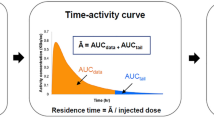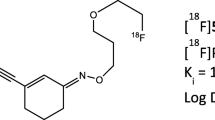Abstract
Purpose
We measured the whole-body distribution of IV-injected [11C]GSK215083, a new 5-HT6 antagonist PET tracer, as a function of time in adult subjects, in order to determine the radiation exposure.
Procedures
After injection with a single bolus of [11C]GSK215083 (range 330–367 MBq; mean 346 MBq), PET emission data were acquired for approximately 120 min in six subjects (three males and three females). Five organs were identified as exhibiting uptake above background. For these, regions of interest were delineated on emission images, and time–activity curves (TAC) generated. Residence times were calculated as the area under the curve of the TAC, normalized to injected activities and standard values of organ volumes. Dosimetry calculations were then performed using the computer program OLINDA/EXM 1.0.
Results
The mean effective dose averaged over both males and females (±standard deviation) was estimated to be 7.7 ± 1.0 μSv/MBq (male 7.0 ± 0.4; female 8.5 ± 0.6). For the effective dose equivalent, the corresponding values are 7.8 ± 1.2 μSv/MBq (male 6.8 ± 0.5; female 8.9 ± 0.1). The organ receiving the highest dose was the lung, with an average equivalent dose of 25.6 ± 6.9 μSv/MBq (male 20.8 ± 5.6; female 30.4 ± 4.4).
Conclusion
The estimated radiation dose for [11C]GSK215083 is consistent with those for other neuroreceptor ligands labeled with carbon-11. The somewhat higher dose estimate for females compared to males may reflect the difference in observed residence times and representative differences in the male and female phantoms used for dosimetry calculations. Based on conventionally accepted dose limits, [11C]GSK215083 may be used for multiple PET scans in the same subject.


Similar content being viewed by others
References
Ruat M, Traiffort E, Arrang JM, Tardivel-Lacombe J, Diaz J, Leurs R et al (1993) A novel rat serotonin (5-HT6) receptor: molecular cloning, localization and stimulation of cAMP accumulation. Biochem Biophys Res Commun 193(1):268–276
Monsma FJ, Shen Y, Ward RP, Hamblin MW, Sibley DR (1993) Cloning and expression of a novel serotonin receptor with high affinity for tricyclic psychotropic drugs. Mol Pharmacol 43(3):320–327
Yang G, Qiu C, Zhao H, Liu Q, Shao Y (2006) Expression of mRNA for multiple serotonin (5-HT) receptor types/subtypes by the peripheral blood mononuclear cells of rhesus macaques. J Neuroimmunol 178(1–2):24–29
Stefulj J, Jernej B, Cicin-Sain L, Rinner I, Schauenstein K (2000) mRNA expression of serotonin receptors in cells of the immune tissues of the rat. Brain Behav Immun 14(3):219–224
Bourson A, Borroni E, Austin RH, Monsma FJ, Sleight AJ (1995) Determination of the role of the 5-ht6 receptor in the rat brain: a study using antisense oligonucleotides. J Pharmacol Exp Ther 274(1):173–180
Bourson A, Boess FG, Bös M, Sleight AJ (1998) Involvement of 5-HT6 receptors in nigro-striatal function in rodents. Br J Pharmacol 125(7):1562–1566
Bentley JC, Bourson A, Boess FG et al (1999) Investigation of stretching behaviour induced by the selective 5-HT6 receptor antagonist, Ro 04–6790, in rats. Br J Pharmacol 126(7):1537–1542
Lacroix LP, Dawson LA, Hagan JJ, Heidbreder CA (2004) 5-HT6 receptor antagonist SB-271046 enhances extracellular levels of monoamines in the rat medial prefrontal cortex. Synapse 51(2):158–164
Woolley ML, Bentley JC, Sleight AJ, Marsden CA, Fone KC (2001) A role for 5-ht6 receptors in retention of spatial learning in the Morris water maze. Neuropharmacology 41(2):210–219
Rogers DC, Hagan JJ (2001) 5-HT6 receptor antagonists enhance retention of a water maze task in the rat. Psychopharmacology (Berl) 158(2):114–119
Perez-García G, Meneses A (2005) Oral administration of the 5-HT6 receptor antagonists SB-357134 and SB-399885 improves memory formation in an autoshaping learning task. Pharmacol Biochem Behav 81(3):673–682
Woolley ML, Marsden CA, Fone KCF (2004) 5-ht6 receptors. Curr Drug Targets CNS Neurol Disord 3(1):59–79
Upton N, Chuang TT, Hunter AJ, Virley DJ (2008) 5-HT6 receptor antagonists as novel cognitive enhancing agents for Alzheimer’s disease. Neurotherapeutics 5(3):458–469
Martarello L, Cunningham VJ, Matthews JC, Rabiner E, Jakobsen S, Gee AD (2005) Radiolabelling and in vivo evaluation of [11C]GSK215083 as potential PET radioligand for the 5-HT6 receptor in the porcine brain. J Cereb Blood Flow Metab 25(S1):S598
Parker CA, Cunningham V, Martarello L et al (2008) Evaluation of the novel 5-HT6 receptor radioligand, [11C]GSK-215083 in human. NeuroImage 41(Supplement 2):T20
Wilson AA, DaSilva JN, Houle S (1994) Facile radiolabelling and purification of 2β-[O-11CH3]-carbomethoxy-3β-aryltropanes: radiotracers for the dopamine transporter. J Label Compd Radiopharm 34:759–765
Wilson AA, Garcia A, Jin L, Houle S (2000) Radiotracer synthesis from [(11)C]-iodomethane: a remarkably simple captive solvent method. Nucl Med Biol 27(6):529–532
Brambilla M, Secco C, Dominietto M, Matheoud R, Sacchetti G, Inglese E (2005) Performance characteristics obtained for a new 3-dimensional lutetium oxyorthosilicate-based whole-body PET/CT scanner with the National Electrical Manufacturers Association NU 2–2001 standard. J Nucl Med 46(12):2083–2091
Defrise M, Kinahan PE, Townsend DW, Michel C, Sibomana M, Newport DF (1997) Exact and approximate rebinning algorithms for 3D-PET data. IEEE Trans Med Imaging 16(2):145–158
Hamill JJ, Hawman EG (1995) Evaluating a frequency–space SPECT reconstruction algorithm. SPIE vol. 2622. Proc Opt Eng Midwest 95:785–791
Watson CC, Newport D, Casey ME, de Kemp RA, Beanlands RS, Schmand M (1997) Evaluation of simulation-base scatter correction for 3D PET cardiac imaging. IEEE Trans Nucl Sci 44(1):90–97
Stabin MG, Sparks RB, Crowe E (2005) OLINDA/EXM: the second-generation personal computer software for internal dose assessment in nuclear medicine. J Nucl Med 46(6):1023–1027
van der Aart J, Hallett WA, Rabiner EA, Passchier J, Comley RA (2011) Radiation dose estimates for carbon-11-labelled PET tracers. Nucl Med Biol. 2011 Oct 25.[Epub ahead of print]
ICRP (1991) 1990 Recommendations of the International Commission on Radiological Protection. Ann ICRP 21(1–3):1–201
ICRP (2007) The 2007 Recommendations of the International Commission on Radiological Protection. ICRP Publication 103. Ann ICRP 37(2–4):1–332
ICRP (1991) Radiological Protection in Biomedical Research. A report of Committee 3 adopted by the International Commission on Radiological Protection. Ann ICRP 22(3):1–28, v–xxiv
“Radioactive drugs for certain research uses.” Code of Federal Regulations Title 21, Part 361.1 2011. http://www.accessdata.fda.gov/scripts/cdrh/cfdocs/cfcfr/CFRSearch.cfm?fr=361.1 Accessed 22 June 2011
Acknowledgments
The authors would like to gratefully acknowledge the help of the following staff at the CAMH PET center who were instrumental in conducting this piece of work: Peter Bloomfield, Jeannie Fong, Armando Garcia, Winston Stableford, and Min Wong. In addition we would like to acknowledge the support of Jan Passchier of GlaxoSmithKline for the many helpful conversations over the years concerning the role of radiation protection in our research studies.
Conflict of Interest
At the time this work was conducted. RAC, CS, WH, NK, EAR and ML were employees of and owners of stock/options in GlaxoSmithKline. AAW and SH have received grants from GlaxoSmithKline.
Author information
Authors and Affiliations
Corresponding author
Rights and permissions
About this article
Cite this article
Comley, R.A., Salinas, C., Mizrahi, R. et al. Biodistribution and Radiation Dosimetry of the Serotonin 5-HT6 Ligand [11C]GSK215083 Determined from Human Whole-Body PET. Mol Imaging Biol 14, 517–521 (2012). https://doi.org/10.1007/s11307-011-0523-1
Published:
Issue Date:
DOI: https://doi.org/10.1007/s11307-011-0523-1




